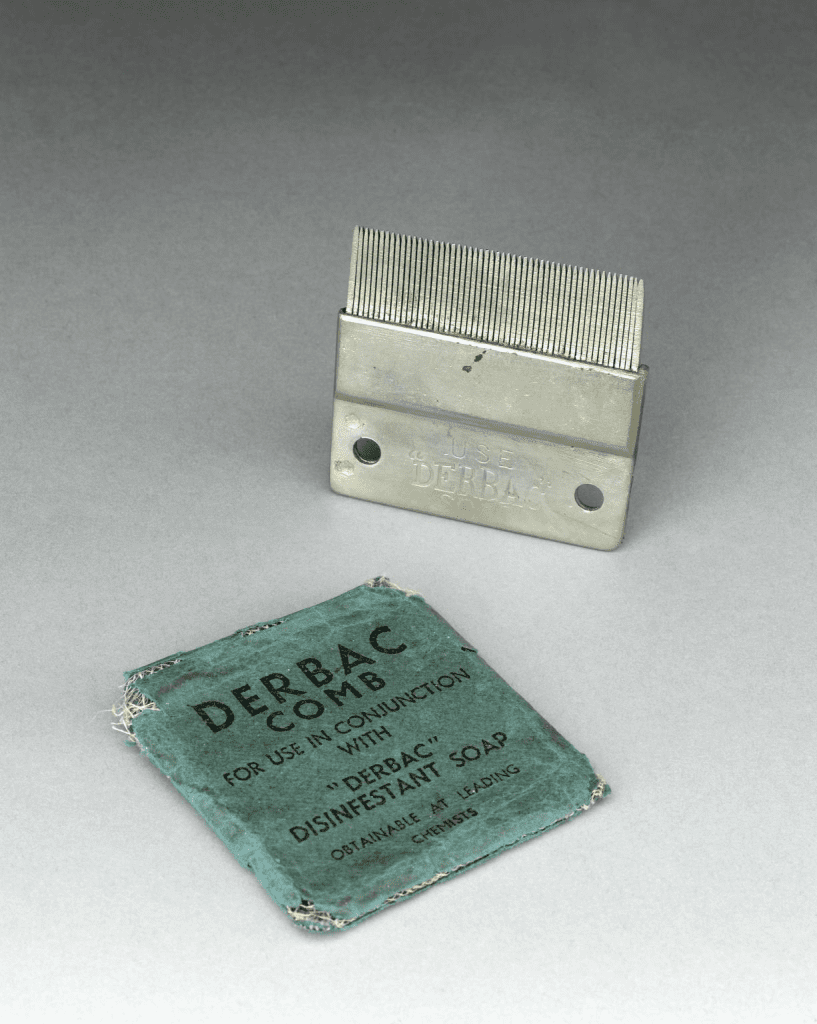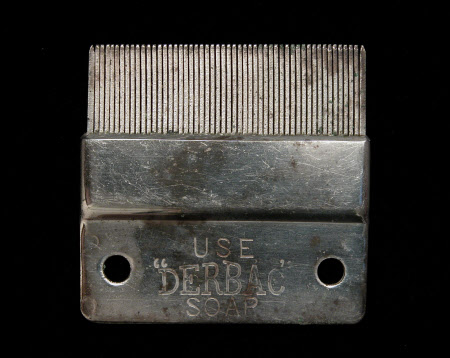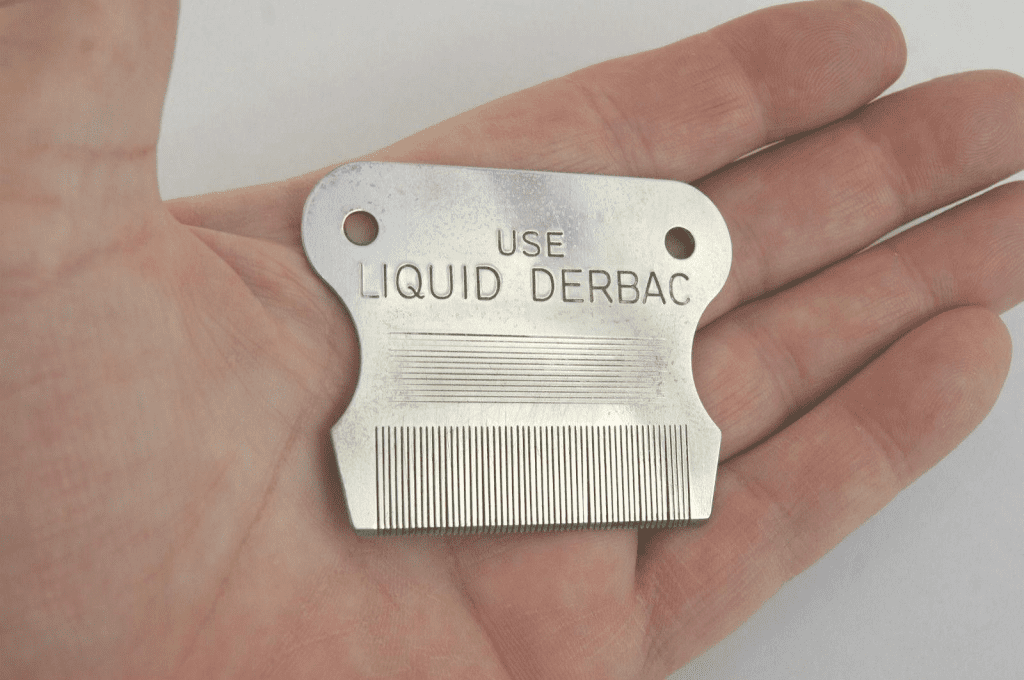Head lice, a persistent nuisance throughout history, have plagued children and adults alike. For decades, tools like the vintage Derbac soap nit comb stood as essential allies in the fight against these tiny invaders. This metal lice comb, created in England during the 1930s and 1940s, was a staple for removing lice and their eggs (nits) from human hair. Let’s explore the history, significance, and functionality of this timeless tool.

What Is the Derbac Soap Nit Comb?
The Derbac soap nit comb is a finely-toothed metal comb designed specifically for lice removal. It was often paired with Derbac soap, a medicated cleansing agent used to help loosen lice and nits from hair. Packaged in a paper envelope with detailed instructions, this comb was a practical and durable tool used both in homes and schools.
The comb’s metal teeth were precisely spaced to catch lice and their eggs, ensuring a thorough removal process. Unlike many modern plastic combs, the Derbac nit comb’s robust metal design made it highly effective and reusable.
The History of the Nit Comb
A Common Problem Across Generations
Head lice have been a persistent issue for centuries, particularly in communal settings like schools. Passed through direct contact or shared personal items such as combs, brushes, or hats, lice outbreaks were almost a rite of passage for many schoolchildren.
During the 1930s and 1940s, the prevalence of head lice was so significant that schools employed “nit nurses” to conduct regular lice inspections. The nit nurse, though dreaded by students, was tasked with identifying infestations and ensuring affected children received proper treatment.
The Derbac Brand
The Derbac brand emerged as a trusted name for tackling lice infestations. Known for its medicated soap and sturdy nit combs, Derbac provided families with a reliable solution. These combs were affordable, reusable, and designed to last—a reflection of the practical needs of the time.
How the Derbac Nit Comb Worked
The effectiveness of the Derbac nit comb lay in its simplicity and precision. Here’s how it worked:
- Preparation
Hair was first washed with Derbac soap or another medicated product to loosen the grip of lice and nits on the hair shaft. The soap’s ingredients often included compounds designed to suffocate or weaken lice. - Combing Process
The nit comb was then used on damp hair, section by section. Its closely spaced metal teeth were perfect for catching lice and dragging out stubborn nits clinging to hair strands. - Cleaning the Comb
After each pass through the hair, the comb was wiped clean with a tissue or cloth to remove captured lice and eggs. This prevented re-infestation during the combing process. - Repeat Treatment
To ensure complete removal, the process was repeated over several days, checking for new lice that might have hatched from missed eggs.
Why Metal Nit Combs Were So Effective

1. Durability and Precision
Unlike plastic alternatives, the metal construction of the Derbac comb ensured durability and precision. The teeth were rigid and evenly spaced, which was crucial for grabbing lice and nits without breaking.
2. Reusability
Metal nit combs like Derbac’s were designed to last, making them a cost-effective solution. They could be sterilized with boiling water, ensuring hygiene between uses.
3. Compatibility with Medicated Soaps
Pairing the comb with medicated products like Derbac soap enhanced its effectiveness. The soap loosened nits, making them easier to remove, while the comb physically eradicated lice and eggs from the scalp.
The Role of Nit Nurses in Schools
During the early to mid-20th century, school inspections for head lice were commonplace. Nit nurses, often feared by students, conducted thorough checks and provided treatment recommendations to families. Tools like the Derbac nit comb were essential during these inspections, as they offered a reliable method for lice removal.
Although these inspections were invasive and embarrassing for many children, they were vital in controlling outbreaks in communal settings.
Modern Relevance of Vintage Nit Combs
While technology and treatments have evolved, the principles behind the vintage Derbac nit comb remain relevant. Many modern nit combs still follow the same basic design, highlighting the timeless effectiveness of this simple tool.
Why Vintage Tools Still Matter

- Sustainability: Metal combs are more environmentally friendly than disposable plastic ones.
- Efficiency: The precision of closely spaced metal teeth often surpasses that of modern plastic designs.
- Nostalgia and Collectibility: Vintage tools like the Derbac comb hold historical and sentimental value, offering a glimpse into past practices.
Tips for Using Nit Combs Effectively Today
If you’re dealing with a lice infestation, here’s how to get the most out of a nit comb:
- Start with Damp Hair: Wet hair makes it easier to glide the comb through and reduces lice mobility.
- Use Conditioner or Medicated Products: Applying conditioner or anti-lice treatments helps loosen nits for easier removal.
- Work in Sections: Divide the hair into small sections to ensure every strand is thoroughly combed.
- Clean the Comb Frequently: After each pass, wipe the comb to prevent reintroducing lice into the hair.
- Inspect Regularly: Continue checking the hair for several days to catch any newly hatched lice.
Conclusion: The Legacy of the Derbac Soap Nit Comb
The vintage Derbac soap nit comb stands as a testament to the ingenuity of past generations in tackling everyday challenges. Its durable design, paired with practical application, made it a trusted tool for families and schools alike.
Though modern solutions have expanded, the principles behind the Derbac comb remain unchanged. Whether for nostalgia or practicality, this iconic nit comb continues to remind us of the value of simple, effective tools in maintaining hygiene and health.


